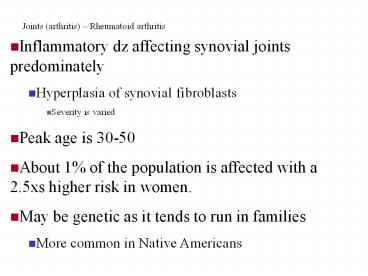Joints (arthritis) Rheumatoid arthritis Inflammatory dz - PowerPoint PPT Presentation
1 / 32
Title:
Joints (arthritis) Rheumatoid arthritis Inflammatory dz
Description:
Joints (arthritis) Rheumatoid arthritis Inflammatory dz affecting synovial joints predominately Hyperplasia of synovial fibroblasts Severity is varied – PowerPoint PPT presentation
Number of Views:353
Avg rating:3.0/5.0
Title: Joints (arthritis) Rheumatoid arthritis Inflammatory dz
1
Joints (arthritis) Rheumatoid arthritis
- Inflammatory dz affecting synovial joints
predominately - Hyperplasia of synovial fibroblasts
- Severity is varied
- Peak age is 30-50
- About 1 of the population is affected with a
2.5xs higher risk in women. - May be genetic as it tends to run in families
- More common in Native Americans
2
- Insidious over several weeks usu.
- Usu. Not symmetric at the beginning
- Must have an inflammatory synovitis
- If deformity is in a non-wt bearing jnt, you can
assume its due to synovitis - 85 have serum RF
- May start sero-(-) but become sero() w/
progression - ESR is typically helpful to follow the
inflammatory activity
3
- Prolonged morning stiffness is universal
- Active phase warm, swollen jnts Structural
damage - Bone on bone crepitus
- Try injected corticosteroids for
anti-inflammation - C/s neck stiffness w/ possible loss of motion
- C1 transverse lig tenosynovitis and possible
z-jnt synovitis - Pain doesnt always accompany instability even in
significant myelopathy
4
(No Transcript)
5
(No Transcript)
6
(No Transcript)
7
(No Transcript)
8
(No Transcript)
9
(No Transcript)
10
(No Transcript)
11
(No Transcript)
12
(No Transcript)
13
(No Transcript)
14
(No Transcript)
15
(No Transcript)
16
(No Transcript)
17
- Immobilization due to pain is the kiss of death
to joint mobilizations. The result is
contractures and deformity - You need to keep pts ROM esp. in non-wt bearing
jnts like shoulder and hand - Once cartilage is completely gone, bones may fuse
if immobilized10 remit usu in first two yrs of
dz - 90 of jnts that are affected are involved during
the 1st yr - Severe dz 10-15yr decr in life expectancy due to
infection, pulmonary or renal dz,
lymphoproliferative disorders, GI bleeds and
cardiovascular
18
- RA criteria below
- Morning stiffness
- 3jnts
- Arthritis of hand
- Symmetric arthritis
- Rheumatoid nodules
- RF
- X-ray changes
- Need 4 of the 7
- 1-4 must occur for at least 6 wks
19
- Stage I Early no destruction
- Stage II Moderate no jnt deformity,
osteoporosis w/ or w/out some bone and cartilage
destruction - Stage III Severe cartilage and bone destruction
with osteoporosis, jnt deformity - Stage IV Terminal fibrous or bony ankylosis
20
- Remission criteria
- 5 of the following for 2 consecutive mos.
- Morning stiffnesslt/15minutes
- No fatigue
- No jnt pain
- No tenderness
- No swelling
- ESR
21
- GOUT
- Monosodium urate deposition - hyperuricemia
- Tophi accumulation of crystal in articular,
osseous, ST, and cartilage - Recurrent attacks of inflammation
- Uric acid calculi in GU renal fxn impairment
called gouty nephropathy - M/c 5th decade men African-Americans
- Serum urate levels rise over time in men but
dont in women until after menopause due to
estrogen - Gout in women is often due to thiazide diuretic
use and renal failure - Blacks due to more HTN, not genetic
22
- Crystals have decr solubility in low temps thats
why it likes toes and ears - Likes areas of minor trauma like 1st MTP
- Hemiplegia tophi wont form on paralyzed side
-gt something to do w/ CT structure and turnover - Tophi is inflammatory cells around crystal w/
erosion of surrounding cartilage and bone.
Fibrous capsule around tophi - Crystals are needle-shaped and formed radially
23
- Three stages asymptomatic hyperuricemia, acute
intermittent gout, Chronic tophaceous gout. - Initially rubor, tubor, dolor and pain of jnt.
Pain incr. Over hours. Pt. May not be able to
walk. May get fever, chills, malaise. May last
up to 2 weeks. Attacks become more frequent w/
time - ½ involve 1st MTP as monoarticular site and 90
of pts overall
24
(No Transcript)
25
- CHRONIC TOPHACEOUS GOUT
- About 10yrs after initial dx usu.
- No pain free period but not as severe as acute
- Factors for tophi development early onset, long
active phases, 4attacks/yr, UE or polyarticular
episodes - Tophi can also be in heart valves and sclera
- Supcutaneous gouty tophy are usu in fingers
heberdens nodes
26
- Early onset gout
- lt25yoa, 3-6 of gout pts, 80 have FHx
- More severe and rapid course, 25 have
nephrolithiasis - Transplant gout
- 75-80 of heart transplants
- Due to cycloporine tx to prevent rejection
- Inhibits urate excretion
27
(No Transcript)
28
(No Transcript)
29
- 10 die of renal failure 25 have renal stones
- 25-50 have HTN -gtdue to reduced renal blood flow
from urate - Hyperlipidemia/obesity contraversial
- Xray ST swelling -gt asymmetric in peripheral
jnts erosions slightly removed from jnt (unique)
(overhanging edge) - No osteopenia, and maintained jnt space until late
30
Osteoarthritis
31
(No Transcript)
32
- OA
- Garrod in 1907 differentiated RA from OA10 of OA
patients had reduced work hours and 13.7 retired
early. - Arthritis is the main reason for decr. Activities
in the elderly































